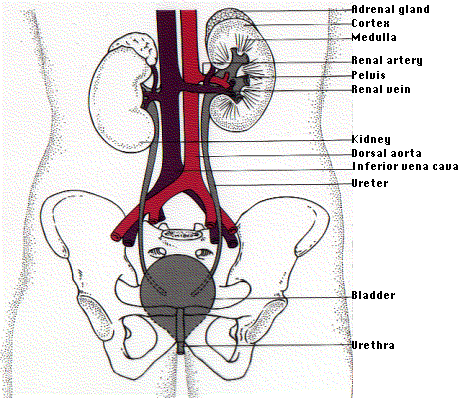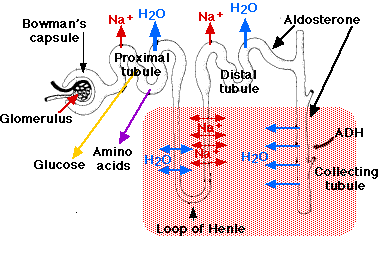A LITTLE BACKGROUND
The human kidneys:
• are two bean-shaped organs, one on each side of
the backbone.
• Represent about 0.5% of the total weight of the
body,
• but receive 20-25% of the total arterial blood pumped
by the heart.
• Each contains from one to two million nephrons

The nephron is a tube; closed
at one end, open at the other. It consists of a:
• Bowman's
capsule. Located at the closed end, the wall
of the nephron is pushed in forming a double-walled chamber.
• Glomerulus.
A capillary network within the Bowman's capsule. Blood
leaving the glomerulus passes into a second capillary network
(not shown in the figure) surrounding the
• Proximal convoluted tubule.
Coiled and lined with cells carpeted with microvilli and
stuffed with mitochondria.
• Loop of Henle. It
makes a hairpin turn and returns to the
• Distal convoluted tubule,
which is also highly coiled and surrounded by capillaries.
• Collecting tubule. It
leads to the pelvis of the kidney from where urine flows
to the bladder and, periodically, on to the outside world.

Formation of Urine
The nephron makes urine by
• filtering the blood of its small molecules and ions
and then
• reclaiming the needed amounts of useful materials.
• Surplus or waste molecules and ions are left to
flow out as urine.
In 24 hours the kidneys reclaim
• ~1,300 g of NaCl
• ~400 g NaHCO3
• ~180 g glucose
• almost all of the180 liters of water that entered
the tubules.
The Kidney and Homeostasis
While we think of the kidney as an organ of excretion, it
is more than that. It does remove wastes, but it also removes
normal components of the blood that are present in greater-than-normal
concentrations. When excess water, sodium ions, calcium
ions, and so on are present, the excess quickly passes out
in the urine. On the other hand, the kidneys step up their
reclamation of these same substances when they are present
in the blood in less-than-normal amounts. Thus the kidney
continuously regulates the chemical composition of the blood
within narrow limits. The kidney is one of the major homeostatic
devices of the body.
Hormones of the Kidneys
The human kidney is also an endocrine
gland secreting two hormones:
• Erythropoietin
(EPO)
• Calcitriol (1,25[OH]2
Vitamin D3), the active form of vitamin D
as well as the enzyme renin.
Ref: and for more information: http://users.rcn.com/jkimball.ma.ultranet/BiologyPages/K/Kidney.html